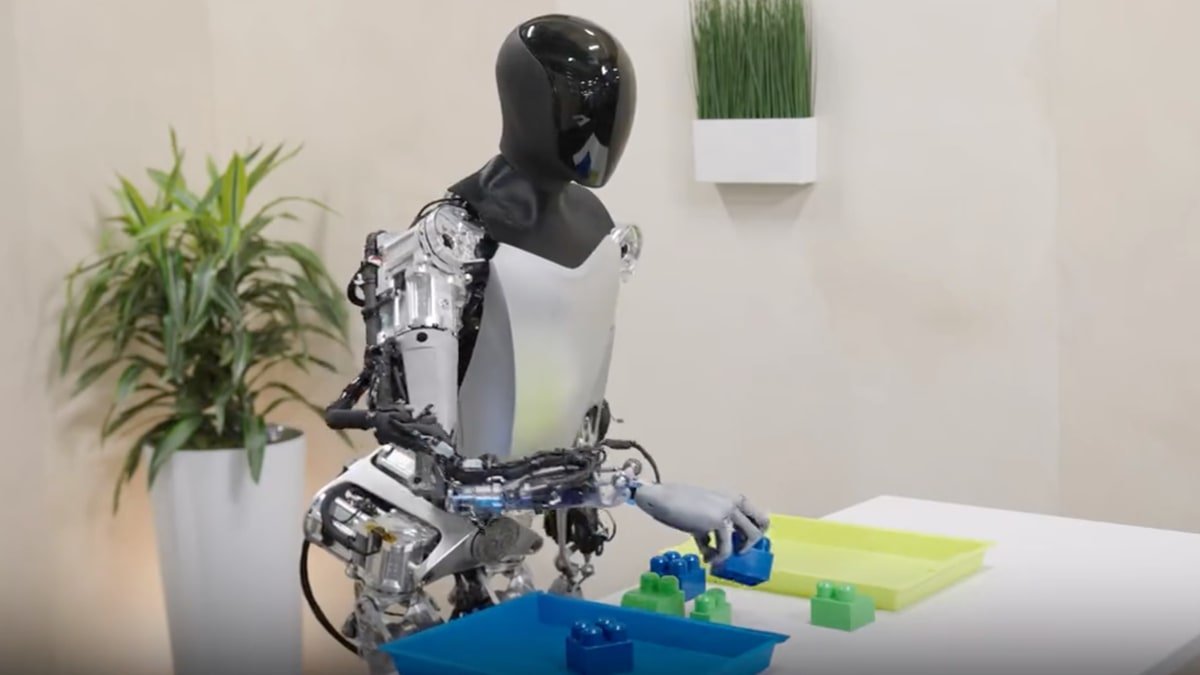테슬라 옵티머스의 학습 방식에 대한 심층 분석: 디지털 드림과 AI 시뮬레이션

진정한 휴머노이드 로봇을 만드는 데 있어 가장 큰 과제 중 하나는 데이터입니다. 사람이 직접 모든 작업을 보여주지 않고도 로봇이 수천 가지의 다양하고 복잡한 인간 작업을 수행하는 법을 어떻게 학습할 수 있을까요?
최근 X에서의 대화에서 엘론은 테슬라의 솔루션을 명확히 설명했는데, 이는 물리적 훈련을 훨씬 뛰어넘어 디지털 꿈의 영역으로 확장되는 혁신적인 접근 방식입니다.
테슬라도 옵티머스를 위해 이걸 가지고 있습니다. 말씀하신 대로, 휴머노이드 로봇 훈련에 필수적이죠.
체력 훈련은 막다른 길입니다
이 획기적인 기술을 이해하려면 먼저 병목 현상이 정확히 무엇인지 이해해야 합니다. 전통적으로 로봇을 훈련하는 주된 방법은 인간의 원격 조작입니다. 조작자는 센서가 장착된 특수 장비를 착용하고 로봇에게 무엇을 어떻게 움직여야 하는지 가르칩니다. 그리고 이 작업은 훈련 데이터를 위해 기록됩니다.
엔비디아의 로보틱스 부문 이사인 짐 팬은 최근 이 방식을 로봇 공학의 "화석 연료"라고 표현했습니다. 효과적이지만 엄청나게 느리고, 비용이 많이 들며, 확장이 어려운 방식입니다. 인간 작업자가 모든 가능한 환경에서 모든 가능한 물체를 사용하여 상상할 수 있는 모든 작업을 실제로 시연할 수는 없습니다. 이러한 데이터 문제는 범용 로봇이 공상과학 소설의 영역에 머물러 있는 주된 이유입니다.
디지털 드림 & 합성 데이터
테슬라와 엔비디아가 각각 독자적으로 추진하고 있는 해결책은 팬이 로봇 공학의 "청정 에너지"라고 부르는 대규모 합성 데이터 생성으로 전환하는 것입니다. 핵심 개념은 OpenAI의 Sora나 구글의 Veo와 유사한 강력한 비디오 생성 AI 모델을 "신경 물리 엔진"으로 사용하는 것입니다. 이러한 모델은 로봇이 학습하고 연습할 수 있는 시뮬레이션된 세계, 즉 "디지털 꿈"을 만들어낼 수 있으며, 물리적 서보를 전혀 움직이지 않고도 방대한 양의 훈련 데이터를 생성합니다.
일론 머스크는 테슬라가 이미 옵티머스에 동일한 접근 방식을 사용하고 있다고 확인하며, 이것이 휴머노이드 로봇 훈련에 필수적이라고 말했습니다. 테슬라는 옵티머스와 FSD 모두에 이러한 방식을 적용하고 있습니다. 테슬라가 특허에서 언급하는 것처럼 합성 훈련 데이터, 즉 시뮬레이션 콘텐츠를 생성하면 실제 환경에서 복제할 필요 없이 특정 작업이나 예외적인 상황을 훈련하는 데 도움이 됩니다.
기본적으로 이 기능은 실제 작업(예: 셔츠 접는 수천 개의 영상)을 기반으로 합성 학습 데이터를 생성하여 실제 학습을 보완합니다. Optimus의 FSD는 셔츠 접는 방법을 학습할 때까지 물리적으로 수행할 필요 없이 이 단일 작업에 대해 수백 또는 수천 번의 반복 학습을 수행합니다.
자세한 내용이 궁금하다면 Tesla가 합성 학습 데이터를 생성하고 사용하는 방법에 대한 특허 심층 분석을 여기에서 확인하세요.
디지털 꿈을 위한 레시피
테슬라의 정확한 방법은 영업 비밀이지만, 엔비디아 AI 연구소의 DreamGen 프로젝트에 대한 최근 연구는 이 강력한 합성 데이터를 생성하는 방법에 대한 전례 없는 통찰력을 제공합니다. 생성 비디오 모델을 다재다능한 로봇 시뮬레이터로 전환하는 이 과정은 네 가지 주요 단계로 나눌 수 있습니다.
먼저, 물리 엔진을 미세 조정합니다. 이 과정은 최첨단 비디오 생성 모델을 사용하여 대상 로봇의 기존 비디오를 미세 조정하는 것으로 시작됩니다. 이 중요한 단계를 통해 AI 모델은 로봇의 특정 물리 법칙, 즉 팔다리의 움직임, 손의 그립, 그리고 세상과 상호 작용하는 방식을 학습하게 됩니다.
다음으로, 언어를 사용하여 현실 세계를 시뮬레이션합니다. AI가 로봇을 이해하면, 개발자는 일반 언어 프롬프트를 사용하여 로봇이 물리적으로 훈련받지 않은 새로운 작업을 수행하는 영상을 생성할 수 있습니다. 예를 들어, "픽 앤 플레이스"에 대한 현실 세계 데이터 세트만 가진 로봇에게 붓기, 접기, 퍼내기, 심지어 다림질하는 꿈을 꾸도록 할 수 있습니다. 그러면 시스템과 엔지니어는 로봇이 지시를 제대로 따르지 않는 "나쁜 꿈"을 걸러낼 수 있습니다.
그 결과, 실사 영상으로 구성된 방대한 라이브러리가 생성됩니다. 다음 단계는 다른 모델을 사용하여 이러한 영상을 분석하고 꿈 속의 움직임에 해당하는 특정 운동 동작과 제어 명령인 "가상 동작"을 복원하는 것입니다.
마지막으로, 이 과정은 엔비디아가 신경 궤적이라고 부르는 결과를 낳습니다. 꿈 영상은 해당 동작 레이블과 연결되고, 로봇의 AI는 표준 지도 학습을 통해 이 방대한 인공 생성 데이터 세트를 기반으로 훈련됩니다.
진정한 일반화의 잠금 해제
이 디지털 꿈 훈련의 성과는 로봇이 이전에 경험하지 못했던 작업과 환경에 자신의 기술을 일반화하는 놀라운 능력입니다. 엔비디아의 연구에 따르면, 단 하나의 실제 작업으로 시작한 휴머노이드 로봇은 단 한 번의 시연 없이도 22가지의 새로운 행동을 학습할 수 있었습니다.
실제로 로봇은 새로운 환경에서 새로운 작업을 수행할 때 성공률이 0%에서 40% 이상으로 증가했는데, 이는 엄청난 역량 도약입니다.
이 접근법은 기존의 수작업 그래픽 엔진에 비해 엄청난 이점을 제공합니다. 생성 모델은 변형 가능한 물체, 유체 또는 복잡한 조명과 같은 복잡한 물리 현상을 처리하기 위해 특별히 구체화될 필요가 없습니다. AI에게 모든 세계는 아무리 복잡하더라도 신경망을 통한 시뮬레이션일 뿐입니다.
이 놀라운 확장성은 바로 테슬라의 AI 연구를 이끄는 원동력입니다. 차량용 FSD와 옵티머스용 FSD 모두에서 그렇습니다. 이 방법은 필수적이며, 로봇이 현실 세계를 학습하는 유일한 방법입니다. 옵티머스에 필요한 광범위하고 일반적인 지능을 달성하기 위해 테슬라는 물리적 현실이 따라올 수 없는 방식으로 확장된 학습을 가능하게 하는 대규모 합성 데이터 엔진을 구축하는 데 주력하고 있습니다.


